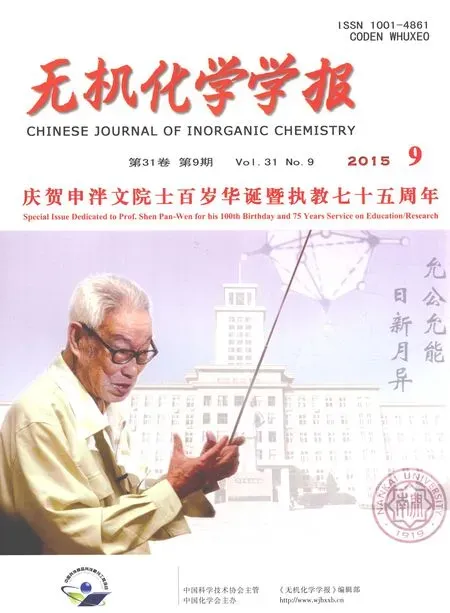β-环糊精修饰的荧光金纳米簇的合成及其在细胞成像上的应用
孙敬华张卫谭彩萍计亮年毛宗万
(生物无机与合成化学教育部重点实验室;中山大学化学与化学工程学院,广州510275)
β-环糊精修饰的荧光金纳米簇的合成及其在细胞成像上的应用
孙敬华张卫谭彩萍计亮年毛宗万*
(生物无机与合成化学教育部重点实验室;中山大学化学与化学工程学院,广州510275)
通过一锅法水相合成出一种β-环糊精修饰的荧光金簇。该新型金簇具有红色荧光发射、长时间的分散稳定性和荧光稳定性。透射电镜观察其平均粒径为(1.40±0.32)nm。激光共聚焦显示金簇分散在细胞质中,荧光随金簇浓度增加而增强。细胞毒性实验证实该金簇具有良好的生物相容性。表面修饰的β-环糊精,也为金簇载药或者靶向功能化提供了更多可能性,从而进一步拓宽其在生物医学方面的应用。
β-环糊精;金纳米簇;细胞成像
Over the past decade,nanoclusters(NCs)of noble metals,such as gold,silver and copper,with sizes comparable to the fermi wavelength of the electron(<3 nm)have emerged as a fascinating research area in nanomaterials[1-5].In particular,gold nanoclusters(AuNCs)consisting of several to tens of gold atoms have drawn tremendous attention. AuNCs can be synthesized in a simple and convenient way[6-8],and exhibit good biocompatibility and unique optical features[9-11],such as size-dependent fluorescence ranging from visible to near-infrared,good photostability and long luminescence lifetimes(>100 ns).Owing to their attractive properties,fluorescent AuNCs have been recognized as promising candidates for cell imaging, biosensing and ultrasensitive biologicaldetection[11-14].
The chemical structure of the surface ligands and the interaction of the metal core with the organic ligands could heavily affect the stability of nanoparticles[15-16].It has been proved that ligands with at least two binding sites such as lipoic acid and its derivatives can make the metal clusters and semiconductor dots more stable[6,17].Fluorescence probes based on AuNCs have been synthesized and explored for biomedical applications,which broadens the area of fluorescence inorganic nanoparticles[12,18-19]. For instance,Chou and coworkers reported the synthesis of flurorescent AuNCs using insulin as a template.More importantly,the AuNCs shows preservation of natural insulin bioactivity in lowering the blood-glucose level and versatility in cell imaging[18].
Cyclodextrins(CDs)have been widely used in pharmaceutical applications for numerous purposes[20-22].Cyclodextrins commonly composed of six, seven,or eight glucopyranoside monomers,namely, α-cyclodextrin(α-CD),β-cyclodextrin(β-CD),or γcyclodextrin(γ-CD),separately.CDs have a truncated cone structure that has a hydrophilic exterior surface and hydrophobic interior cavity.The presence of β-CD may endow the nanoparticles with superior properties,such as extremely low toxicity,excellent biocompatibility,and good complexation capacity with a variety of lipophilic moieties for delivery or functionalization[23-27].We herein report a new kind of water-soluble highly fluorescent gold nanoclusters modified withβcyclodextrin(AuNCs-CD)for intracellular imaging. Our results indicate that AuNCs-CD have great potential as fluorescent nanoparticles for biomedical applications.
1 Experimental
1.1Materials and methods
β-cyclodextrin(β-CD),potassium iodide(KI), lipoic acid(LA),N,N′-carbonyldiimidazole(CDI) and triethylamine(Et3N)were purchased from Aladdin.Methylpyrrolidone(NMP)and chloroauric acid(HAuCl4·4H2O)were purchased from Alfa Aesar;Triethylenetetramine(Trien),sodium tetrahydridoborate and dimethyl sulfoxide(DMSO)were purchased from J&K Scientific Ltd.3-(4,5-dimethylthiazol-2-yl)-2,5-diphenyltetrazolium bromide(MTT) and Hoechst 33 342 were purchased from Sigma-Aldrich.Foetal bovine serum(FBS)and Roswell Park Memorial Institute 1640(RPMI 1640)medium were purchased from Invitrogen.All reagents were of analytical grade and were used without further purification.Mono-6-o-(p-toluenesulfonyl)-β-CD and Trien-β-CD were synthesized according to the methods reported[28-30].
ESI-MS of LA-Trien-β-CD was obtained on a LC-MS(Thremo LCQ DECA XP,USA).1H NMR was performed on an AVANCE 400 MHz NMR spectrometer(Bruker,Switzerland)using D2O solvent and TMS as the internal standard.The chemical shift was expressed as parts per million (ppm).UV-Vis absorption spectra were recorded with a Cary 300 spectrophotometer(Agilent,USA); Fluorescence spectra were taken on a RF-5301PC Spectrofluorophotometer(Shimadzu,Japan);Transmission electron microscope(TEM)was performed on a JEM-200CX(JEOL,Japan),with an accelerating voltage of 200 kV.The sample was prepared by spreading a drop of the AuNCs-CD dispersion onto a copper net and drying at room temperature.
1.2Synthesis the ligand LA-Trien-β-CD
The synthetic strategy of LA-Trien-β-CD is shown in Scheme 1.LA(64.1 mg,0.31 mmol)and CDI(57.4 mg,0.34 mmol)were mixed,and NMP (2 mL)was slowly added.The mixture was stirred at room temperature under N2for 15 min.Trien-β-CD(200 mg,0.16 mmol)in 2 mL NMP was added into the mixture.After stirring overnight at room temperature,the mixture was added into ice-cold acetone(50 mL),the white product was collected by centrifugation.The product was purified by recrystallization from acetone-ether to give 83.6 mg white powder(36%yield).Anal.Calcd.for C56H98O35N4S2·6H2O:C 43.13;H 7.11;N 3.59;Found:C 43.44;H 7.43;N 3.78.ESI-MS:m/z Calcd.(Found) [M+H]+1451.5(1 451.5).1H NMR(D2O,400 MHz): δ 1.37~2.59(m,15H),2.83~3.32(m,12H)3.58~3.86(m,42H),4.95~5.02(m,7H).(Fig.S1~S2)

Scheme 1 Schematic representation of synthetic strategy for LA-Trien-β-CD(A)and AuNCs-CD(B)
1.3Synthesis and characterization of AuNCs-CD
AuNCs-CD was synthesized by reduction of Au(Ⅱ)using sodium borohydride in the presence of LA-Trien-β-CD,similar to the methods reported[6,31]. LA-Trien-β-CD(24.5 mg,15 μmol)was added to 10 mL deionized water containing NaOH(25 μL,2 mol·L-1).The mixture was stirred for 15 min,followed by the addition of 100 μL of 50 mmol·L-1HAuCl4·3H2O.The solution turned from colorless to light yellow.The reaction mixture was stirred for 5 min, then NaBH4(200 μL,50 mmol·L-1)was added dropwisely under rapid stirring.The reaction mixture was stirred for 15 h at room temperature. The AuNCs-CD was purified three by cycles of centri-fugation filtration using a centrifugal tube with a molecular weight cutoff of 10 kDa.The resulting dispersions were stored at 4℃.
1.4Cell culture
A549 cells were obtained from Experimental AnimalCenterofSun Yat-sen University(Guangzhou, China).Cells were routinely maintained in RPMI 1640 medium supplemented with FBS(10%,V/V) and 1%(V/V)penicillin/streptomycin.The cells were cultured in tissue culture flasks in a humidified incubator at 37℃and in an atmosphere of 5%CO2.
1.5Cytotoxicity assay
Cells were plated at a density of 5000 cells per well in 96-well flat-bottomed microtiter plates (Corning)with 160 μL of cells suspension per well and incubated for 24 h.AuNCs-CD were tested at concentrations from 0.16 to 10 μmol·L-1.Then the growth medium was replaced with RPMI 1640 medium containing different concentrations of AuNCs-CD.After incubation for 44 h,MTT solution (20 μL of 2.5 mg·mL-1in 0.01 mol·L-1sterilized PBS,pH=7.4)was added to each well and the plates were incubated for 4 h at 37℃.The intracellular formazan product was dissolved in 150 μL DMSO and the absorption at 595 nm was quantified by an iMark microplate reader(Bio-Rad,USA).The percentage of cell viability was calculated by usingthe equation:(mean OD of treated cells/mean OD of control cells)×100%.Data were presented as averages of three independent experiments±standard deviations.
1.6Cellimaging with laser confocal microscopy
A549 cells were seeded into a 35 mm dish (Corning)at a density of 1.0×105cells and maintained for 48 h to achieve 70%~80%confluence. Then,cells were transfected with different concentrations of AuNCs-CD and incubated for 6 h.The media was then discarded and the cells were washed 3 times with PBS and fixed with 4% paraformaldehyde at room temperature for 15 min. After washed with PBS,cells were labelled with Hoechst 33 342(5 μg·mL-1in PBS)for 15 min and analyzed immediately with a confocal laser-scanning microscope(LSM 710,Carl Zeiss,Germany) by excitation at 488 nm.
2 Results and discussion
2.1Synthesis and characterization of AuNCs-CD
The synthetic strategy of fluorescent AuNCs-CD is shown in Scheme 1.Fluorescent AuNCs-CD were synthesized by reducing gold salt with NaBH4in the presence of LA-Trien-β-CD in aqueous solution(nAu∶nligand=1∶3).A bright red luminescence from the prepared solution under the UV lamp suggests that a luminescent species is formed during the reaction.Fig.1(black line)presents the absorption spectrum of the prepared AuNCs-CD. The spectrum exhibits a wide absor-ption bands at 700 nm,which arise from mixed intraband(sp to sp)and interband(d to sp)transitions[32-33].In contrast to large Au nanoparticles,ultrasmall Au nanoclusters exhibit excellent photolumi-nescence[34].A strong fluorescence centered on 650 nm in the visible light region was observed from AuNCs-CD in aqueous solution upon excitation at 470 nm (Fig.1,red line).TEM was used to measure the core size of AuNCs-CD,which reveals an average diameter of(1.40±0.32)nm from image analysis of more than 200 individual particles(Fig.2A).The size distribution of AuNCs-CD in aqueous solution is shown in Fig.2B.In addition,the AuNCs-CD shows high water solubility and good dispersion. Indeed,these clusters are stable in water for over 3months without precipitation and the optical properties have negligible change over this period. The ζ potential analysis for surface charge of AuNCs-CD shows that the ζ potential value is (9.90±0.05)mV.The positive charge is expected to facilitate the intracellular uptake of AuNCs-CD.
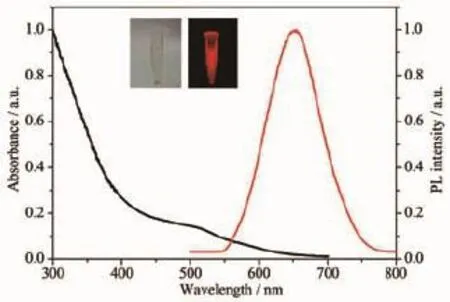
Fig.1 UV-Vis absorption spectrum and fluorescence spectrum of the aqueous solution of AuNCs-CD
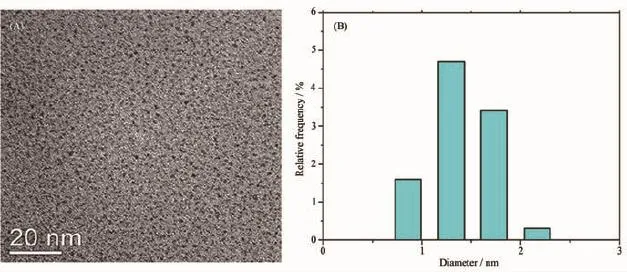
Fig.2 (A)Typical TEM image of AuNCs-CD;(B)Size distribution of the aqueous solution of AuNCs-CD
2.2Cytotoxicity of AuNCs-CD
The cytotoxicity of AuNCs-CD as measured by standard MTT assay in A549 cells for 24 h of incubation shows that the cells viability is more than 80%even at a concentration of 10 μmol·L-1(Fig.3),suggesting good biocompatibility of these clusters.Microscopic observations show no obvious morphological changes in A549 cells treated with AuNCs-CD,suggesting the low cytotoxic effects of AuNCs-CD.The low toxicity of AuNCs-CD indicates that they are suitable for further diagnostic and intracellular imaging applications.
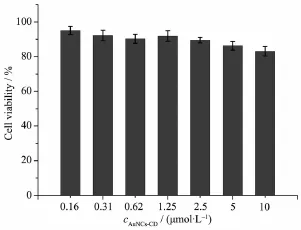
Fig.3 Viability of A549 cells after treating with different concentrations of AuNCs-CD as determined by a MTT assay;Values represent percentage cell viability(mean±SD,n=3)
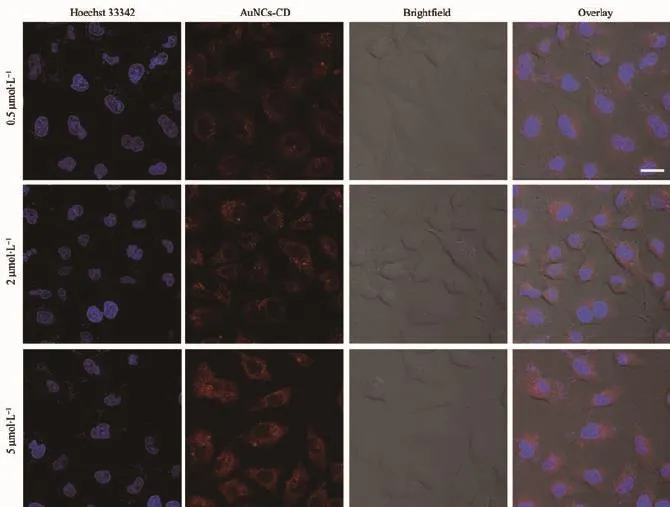
Fig.4 Fluorescence images of HeLa cells treated with different concentrations of AuNCs-CD(0.5,2,5 μmol·L-1) for 6 h(excitation at 488 nm and emission at 550~750 nm);Scale bar:20 μm
2.3Intracellular imaging of AuNCs-CD
Owing to the intrinsic fluorescence of AuNCs, the intracellular behavior of AuNCs-CD can be visualized by the confocal microscopy(Fig.4).Due to the cation surface and small particle diameter ofAuNCs-CD,AuNCs-CD could enter A549 cells and mainly localize in the cytoplasm after 6 h of incubation.The red fluorescence from AuNCs-CD is observed in A549 cells.The intensity of the intracellular red fluorescence from AuNCs-CD increases in a concentration-dependent manner.
3 Conclusions
In summary,a new kind gold nanoclusters modified with β-cyclodextrin was prepared in water solution.The AuNCs-CD has high fluorescence stability,bright red fluorescence emission,small diameter(1.4 nm)and low cytotoxicity.The application of AuNCs-CD as fluorescent nanoprobes in bioimaging has been demonstrated by confocal microscopy.Moreover,modification of cyclodextrins not only enhances the biocompatibility,but also makes AuNCs more versatile for encapsulation of hydrophobic drugs or targeting molecules in the hydrophobic cavities of β-CDs.Hence,multifunctional β-cyclodextrin functionalized AuNCs-based nanoparticles are expected to have potential biomedical applicaions.
Supporting information is available at http://www.wjhxxb.cn
References: ?
[1]Choi S,Dickson R M,Yu J.Chem.Soc.Rev.,2012,41(5): 1867-1891
[2]Tanaka S I,Miyazaki J,Tiwari D K,et al.A ngew.Chem. Int.Ed.,2011,123(2):451-455
[3]Yuan X,Luo Z,Zhang Q,et al.ACS Nano,2011,5(11):8800 -8808
[4]Zhang H,Huang X,Li L,et al.Chem.Commun.,2011,48 (4):567-569
[5]Shang L,Dong S,Nienhaus G U.Nano Today,2011,6(4):401 -418
[6]Shang L,Azadfar N,Stockmar F,et al.Small,2011,7(18): 2614-2620
[7]Wu Z,Suhan J,Jin R.J.Mater.Chem.,2009,19(5):622-626
[8]Xie J,Zheng Y,Ying J Y.J.Am.Chem.Soc.,2009,131(3): 888-889
[9]Biju V.Chem.Soc.Rev.,2014,43(3):744-764
[10]Huang C C,Liao H Y,Shiang Y C,et al.J.Mater.Chem., 2009,19(6):755-759
[11]Shang L,Stockmar F,Azadfar N,et al.Angew.Chem.Int. Ed.,2013,52(42):11154-11157
[12]Chen T,Hu Y,Cen Y,et al.J.Am.Chem.Soc.,2013,135 (31):11595-11602
[13]Palmal S,Basiruddin S,Maity A R,et al.Chem.Eur.J., 2013,19(3):943-949
[14]Sun J,Jin Y.J.Mater.Chem.C,2014,2(38):8000-8011
[15]Schmid G,Fenske D.Phil.Trans.R.Soc.A,2010,368(1915): 1207-1210
[16]Li J J,Wang Y A,Guo W,et al.J.Am.Chem.Soc.,2003, 125(41):12567-12575
[17]Stewart M H,Susumu K,Mei B C,et al.J.Am.Chem.Soc., 2010,132(28):9804-9813
[18]Liu C L,Wu H T,Hsiao Y H,et al.Angew.Chem.Int.Ed., 2011,50(31):7056-7560
[19]Polavarapu L,Manna M,Xu Q H.Nanoscale,2011,3(2):429 -434
[20]Chen G,Jiang M.Chem.Soc.Rev.,2011,40(5):2254-2266
[21]Hu Q D,Tang G P,Chu P K.Acc.Chem.Res.,2014,47(7): 2017-2025
[22]Lai W F.Biomaterials,2014,35(1):401-411
[23]Li J M,Wang Y Y,Zhao M X,et al.Biomaterials,2012,33 (9):2780-2790
[24]Zhao M X,Li J M,Du L,et al.Chem.Eur.J.,2011,17(18): 5171-5179
[25]Shen J,Kim H C,Su H,et al.Theranostics,2014,4(5):487-489
[26]Park C,Youn H,Kim H,et al.J.Mater.Chem.,2009,19 (16):2310-2315
[27]He H,Chen S,Zhou J,et al.Biomaterials,2013,34(21): 5344-5358
[28]Petter R C,Salek J S,Sikorski C T,et al.J.Am.Chem. Soc.,1990,112(10):3860-3868
[29]May B,Kean S,Easton C,et al.J.Chem.Soc.,Perkin Trans.1,1997(21):3157-3160
[30]Liu Y,You C C,Wada T,et al.Tetrahedron Lett.,2000,41 (35):6869-6873
[31]Aldeek F,Muhammed M A H,Palui G,et al.ACS Nano, 2013,7(3):2509-2521
[32]Negishi Y,Nobusada K,Tsukuda T.J.Am.Chem.Soc., 2005,127(14):5261-5270
[33]Muhammed M A H,Verma P K,Pal S K,et al.Chem.Eur. J.,2009,15(39):10110-10120
[34]Yau S H,Varnavski O,Goodson T.Acc.Chem.Res.,2013, 46(7):1506-1516
Synthesis of β-Cyclodextrin Functionalized Fluorescent Gold Nanoclusters for Cellular Imaging
SUN Jing-Hua ZHANG Wei TAN Cai-Ping JI Liang-Nian MAO Zong-Wan*
(MOE Key Laboratory of Bioinorganic and Synthetic Chemistry;Sun Yat-sen University, School of Chemistry and Chemical Engineering,Guangzhou 510275,China)
A new kind of highly fluorescent AuNCs functionalized with β-cyclodextrin(CD)was prepared by using one-pot aqueous reduction of gold precursor.Aqueous dispersion of these red AuNCs exhibits good long-term colloidal stability as well as fluorescent stability.The average diameter of AuNCs-CD is (1.40±0.32)nm as determined by transmission electron microscopy(TEM).Confocal microscopic observation shows that AuNCs-CD can penetrate into cells and mainly localize within the cytoplasm.In vitro cytotoxicity assay indicates that the AuNCs-CD displays very low cytotoxicity against human lung adenocarcinoma A549 cells.Cyclodextrin modification is expected to make AuNCs more versatile for encapsulation of hydrophobic drugs and functionalization with targeting moieties,which will broaden the potential of AuNCs-CD for biomedical applications.
β-cyclodextrin;gold nanoclusters;cellular imaging
O614.123
A
1001-4861(2015)09-1913-06
10.11862/CJIC.2015.239
2015-07-09。收修改稿日期:2015-07-27。
国家自然科学基金(No.21231007)和国家重点基础研究发展计划(973计划)(No.2014CB845604)资助项目。
*通讯联系人。E-mail:cesmzw@mail.sysu.edu.cn

